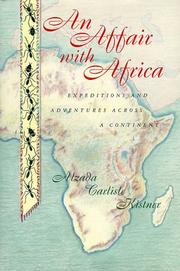| Listing 1 - 5 of 5 |
Sort by
|
Book
ISBN: 9780674241558 Year: 2020 Publisher: Cambridge, Massachusetts : Harvard University Press,
Abstract | Keywords | Export | Availability | Bookmark
 Loading...
Loading...Choose an application
- Reference Manager
- EndNote
- RefWorks (Direct export to RefWorks)
"Army ants are the ultimate social hunters. They are preeminent arthropod predators in tropical rainforests around the world, and their nomadic colonies are the largest among the insect societies. Their troops collectively overwhelm the nests of termites, wasps, and other ants, and kill, dismember, and devour animals that are orders of magnitude larger than the individual army ant. Their massive swarm raids truly are one of nature's greatest spectacles. This book comprehensively synthesizes the literature on army ants, from natural history observations by early explorers of the 18th and 19th century, to modern molecular inquiries into the genetic underpinnings of army ant social life"--
Book
ISBN: 0674249399 0674249410 9780674249417 9780674241558 067424155X Year: 2020 Publisher: Cambridge, Massachusetts
Abstract | Keywords | Export | Availability | Bookmark
 Loading...
Loading...Choose an application
- Reference Manager
- EndNote
- RefWorks (Direct export to RefWorks)
"Army ants are the ultimate social hunters. They are preeminent arthropod predators in tropical rainforests around the world, and their nomadic colonies are the largest among the insect societies. Their troops collectively overwhelm the nests of termites, wasps, and other ants, and kill, dismember, and devour animals that are orders of magnitude larger than the individual army ant. Their massive swarm raids truly are one of nature's greatest spectacles. This book comprehensively synthesizes the literature on army ants, from natural history observations by early explorers of the 18th and 19th century, to modern molecular inquiries into the genetic underpinnings of army ant social life"--
Book
ISBN: 0716709333 Year: 1971 Publisher: San Francisco (Calif.): Freeman
Abstract | Keywords | Export | Availability | Bookmark
 Loading...
Loading...Choose an application
- Reference Manager
- EndNote
- RefWorks (Direct export to RefWorks)
Army ants --- Ants --- Behavior --- -Army ants --- #WDIR:dd.Prof.J.VAN BOVEN --- Dorylinae --- Aculeata --- Formicidae --- Hymenoptera --- Myrmecology --- Army ants. --- Behavior.

ISBN: 1597268321 1417594217 9781417594214 1559635312 9781559635318 Year: 1998 Publisher: Washington, D.C. Island Press
Abstract | Keywords | Export | Availability | Bookmark
 Loading...
Loading...Choose an application
- Reference Manager
- EndNote
- RefWorks (Direct export to RefWorks)
Staphylinidae --- Army ants --- Dorylinae --- Ants --- Aleocharidae --- Brathinidae --- Micropeplidae --- Omalidae --- Oxytelidae --- Rove beetles --- Stenidae (Insects) --- Tachyporidae --- Beetles --- Kistner, Alzada Carlisle --- Travel --- Africa, Sub-Saharan --- Description and travel. --- Description and travel
Book
ISBN: 0691209324 Year: 2020 Publisher: Princeton, NJ : Princeton University Press,
Abstract | Keywords | Export | Availability | Bookmark
 Loading...
Loading...Choose an application
- Reference Manager
- EndNote
- RefWorks (Direct export to RefWorks)
In this pathbreaking and far-reaching work George Oster and Edward Wilson provide the first fully developed theory of caste evolution among the social insects. Furthermore, in studying the effects of natural selection in generally increasing the insects' ergonomic efficiency, they go beyond the concentration of previous researchers on the physiological mechanisms of the insects and turn our attention instead to the scale and efficiency of the insects' division of labor.Recognizing that the efficiency of the insect colony is based on a complex fitting of the division of labor to many simultaneous needs, including those imposed by the distribution of resources and enemies around the nest, Professors Oster and Wilson are able to construct a series of mathematical models to characterize the agents of natural selection that promote particular caste systems.The social insects play a key role in the subject of sociobiology because their social organization is so rigid and can be related to genetic evolution. Because of this important consideration, the authors' work has consequences not only for entomology but also for general evolutionary theory.
Allometric space;Allometry. --- Auslander, D. --- Brian. --- Brown. --- Camponotus (carpenter ants). --- Caste distribution function (CDF). --- Demography. --- Eaton (army ants). --- Energy as utility. --- Formica (ants). --- Guckenheimer, J. --- Hare, Hope. --- Individual-level selection. --- Janzen, D. H. --- Michener, C. D. --- Mirmirani, M. --- Monomorium (ants). --- Myrmica (ants). --- Nash equilibrium. --- Oecophylla (weaver ants), frontispiece. --- Oster, G. F. --- Pheidole (ants). --- Pogonomyrmex (harvesting ants). --- Polistes (paper wasps). --- Resource distribution function (RDF). --- Schmidt, G. H. --- Soldier caste. --- Temporal castes. --- Trivers, R. L. --- Wilson, E. O. --- Allometric space. --- Allometry.
| Listing 1 - 5 of 5 |
Sort by
|

 Search
Search Feedback
Feedback About UniCat
About UniCat  Help
Help News
News